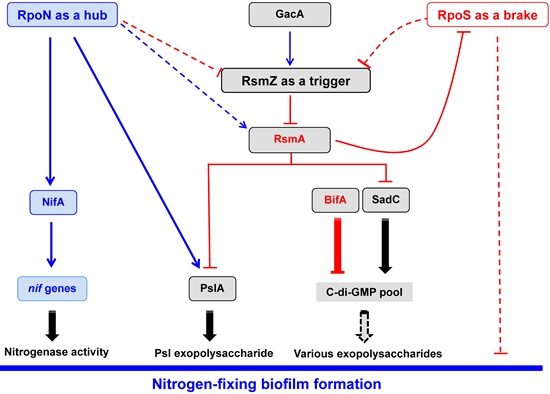The Latest Research of Biotechnology Research Institute Reveals the Network Regulation Mechanism of Nitrogen-fixing Biofilm Formation of Pseudomonas Stutzeri
Recently, the microbial intelligent design and synthesis innovation team of Biotechnology Research Institute of Chinese Academy of Agricultural Sciences has resolved the molecular regulation mechanism of nitrogen-fixing biofilm formation of rice root-associated diazotrophic P. stutzeri A1501. The related result was published in the npj Biofilms and Microbiomes (2020 impact factor 7.29) entitled "A regulatory network involving Rpo, Gac and Rsm for nitrogen-fixing biofilm formation by Pseudomonas stutzeri".
Biofilm refers to a community structure with socialized characteristics formed by microorganisms attached to the surface of living or inanimate media in order to adapt to the complex and changeable natural environment. In biofilm growth state, microorganisms have unique properties in gene expression regulation, physiological and biochemical characteristics and harsh environmental adaptation, such as drug resistance, infectivity and competitiveness, they are the international frontier and hotspot in the field of microbial research. "Biofilm formation" and "biological nitrogen fixation" are two important strategies used by many plant-associated bacteria to adapt to complex environment, however, the mechanisms underlying the formation of nitrogen-fixing biofilms remain largely unknown. This study systematically revealed the regular patterns and characteristics of the formation of nitrogen-fixing biofilm of P. stutzeri A1501, confirmed that under the condition of nitrogen deficiency, this strain had the strongest ability to form nitrogen-fixing biofilm and showed strong capable of nitrogen fixation with tolerating ammonium, and further identified a series of key regulatory factors involved in biofilm formation, such as sigma factors RpoN and RpoS, RNA binding protein RSMA and noncoding RNA (Rsmzy) of Gac/Rsm regulatory system. The regulatory network of nitrogen-fixing biofilm formation was analyzed by footprinting, micro heat surge (MST) and digital PCR; RpoN, as a transcriptional regulatory hub, directly activates the expression of nitrogenase structural gene nifH and extracellular polysaccharide synthesis gene pslA; the noncoding RNA Rsmz, which is expressed at a high level in the early stage of biofilm formation, serves as a signal amplifier to trigger biofilm formation by sequestering the translational repressor protein RsmA away from pslA and sadC mRNAs, the latter of which encodes a diguanylate cyclase that synthesises c-di-GMP; RpoS exerts a braking effect on biofilm formation by transcriptionally downregulating RsmZ expression, while RpoS expression is repressed posttranscriptionally by RsmA. These findings lay an important theoretical foundation for analyzing the interaction mechanism between rhizosphere nitrogen-fixing microorganisms and host crops, greatly enhancing the field nitrogen fixation efficiency and realizing fertilizer saving, yield increasing and efficiency increasing. Concurrently, they provide important theoretical guidance for the design of artificial biofilm module and efficient nitrogen fixation gene circuit.

By Yan Yongliang (yanyongliang@caas.cn)
-
 Apr 18, 2024Opening Ceremony of the Training Workshop on Wheat Head Scab Resistance Breeding and Pest Control in Africa Held in CAAS
Apr 18, 2024Opening Ceremony of the Training Workshop on Wheat Head Scab Resistance Breeding and Pest Control in Africa Held in CAAS -
 Apr 03, 2024IPPCAAS Co-organized the Training Workshop on Management and Application of Biopesticides in Nepal
Apr 03, 2024IPPCAAS Co-organized the Training Workshop on Management and Application of Biopesticides in Nepal -
 Mar 28, 2024Delegation from the School of Agriculture and Food Science of University College Dublin, Ireland Visit to IAS, CAAS
Mar 28, 2024Delegation from the School of Agriculture and Food Science of University College Dublin, Ireland Visit to IAS, CAAS -
 Mar 25, 2024Director of World Food Prize Foundation visited GSCAAS
Mar 25, 2024Director of World Food Prize Foundation visited GSCAAS -
 Mar 20, 2024Institute of Crop Sciences (ICS) and Syngenta Group Global Seeds Advance Collaborative Research in the Seed Industry
Mar 20, 2024Institute of Crop Sciences (ICS) and Syngenta Group Global Seeds Advance Collaborative Research in the Seed Industry
